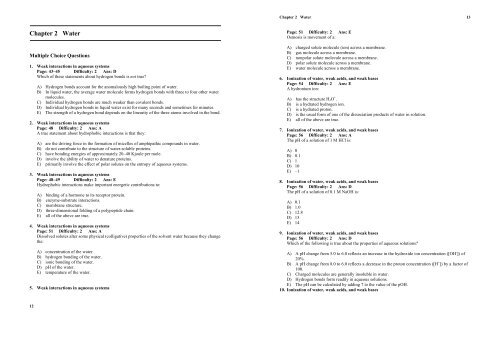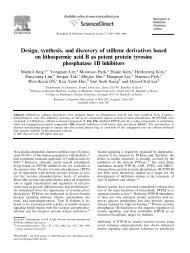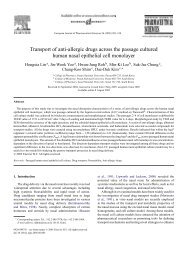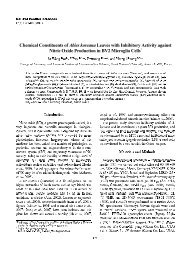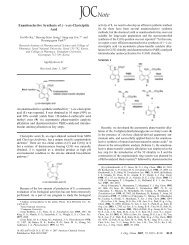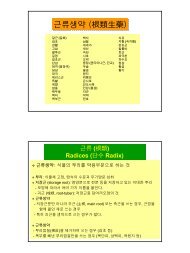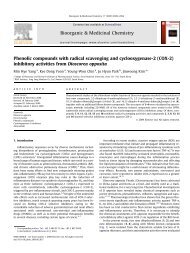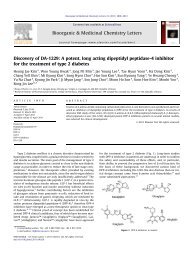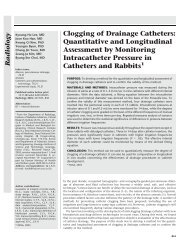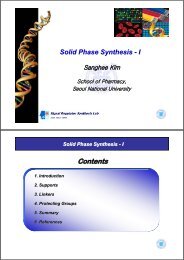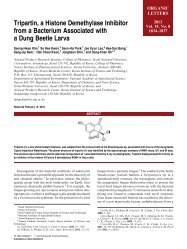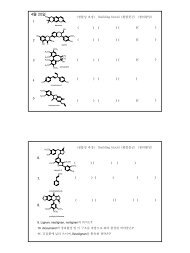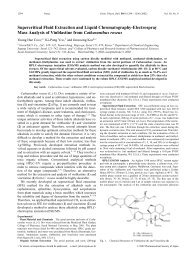Chapter 2 Water
Chapter 2 Water
Chapter 2 Water
You also want an ePaper? Increase the reach of your titles
YUMPU automatically turns print PDFs into web optimized ePapers that Google loves.
<strong>Chapter</strong> 2 <strong>Water</strong> 13<br />
<strong>Chapter</strong> 2 <strong>Water</strong><br />
Multiple Choice Questions<br />
1. Weak interactions in aqueous systems<br />
Page: 43–45 Difficulty: 2 Ans: D<br />
Which of these statements about hydrogen bonds is not true<br />
A) Hydrogen bonds account for the anomalously high boiling point of water.<br />
B) In liquid water, the average water molecule forms hydrogen bonds with three to four other water<br />
molecules.<br />
C) Individual hydrogen bonds are much weaker than covalent bonds.<br />
D) Individual hydrogen bonds in liquid water exist for many seconds and sometimes for minutes.<br />
E) The strength of a hydrogen bond depends on the linearity of the three atoms involved in the bond.<br />
2. Weak interactions in aqueous systems<br />
Page: 48 Difficulty: 2 Ans: A<br />
A true statement about hydrophobic interactions is that they:<br />
A) are the driving force in the formation of micelles of amphipathic compounds in water.<br />
B) do not contribute to the structure of water-soluble proteins.<br />
C) have bonding energies of approximately 20–40 Kjoule per mole.<br />
D) involve the ability of water to denature proteins.<br />
E) primarily involve the effect of polar solutes on the entropy of aqueous systems.<br />
3. Weak interactions in aqueous systems<br />
Page: 48–49 Difficulty: 2 Ans: E<br />
Hydrophobic interactions make important energetic contributions to:<br />
A) binding of a hormone to its receptor protein.<br />
B) enzyme-substrate interactions.<br />
C) membrane structure.<br />
D) three-dimensional folding of a polypeptide chain.<br />
E) all of the above are true.<br />
4. Weak interactions in aqueous systems<br />
Page: 51 Difficulty: 2 Ans: A<br />
Dissolved solutes alter some physical (colligative) properties of the solvent water because they change<br />
the:<br />
A) concentration of the water.<br />
B) hydrogen bonding of the water.<br />
C) ionic bonding of the water.<br />
D) pH of the water.<br />
E) temperature of the water.<br />
5. Weak interactions in aqueous systems<br />
Page: 51 Difficulty: 2 Ans: E<br />
Osmosis is movement of a:<br />
A) charged solute molecule (ion) across a membrane.<br />
B) gas molecule across a membrane.<br />
C) nonpolar solute molecule across a membrane.<br />
D) polar solute molecule across a membrane.<br />
E) water molecule across a membrane.<br />
6. Ionization of water, weak acids, and weak bases<br />
Page: 54 Difficulty: 2 Ans: E<br />
A hydronium ion:<br />
A) has the structure H 3 O + .<br />
B) is a hydrated hydrogen ion.<br />
C) is a hydrated proton.<br />
D) is the usual form of one of the dissociation products of water in solution.<br />
E) all of the above are true.<br />
7. Ionization of water, weak acids, and weak bases<br />
Page: 56 Difficulty: 2 Ans: A<br />
The pH of a solution of 1 M HCl is:<br />
A) 0<br />
B) 0.1<br />
C) 1<br />
D) 10<br />
E) –1<br />
8. Ionization of water, weak acids, and weak bases<br />
Page: 56 Difficulty: 2 Ans: D<br />
The pH of a solution of 0.1 M NaOH is:<br />
A) 0.1<br />
B) 1.0<br />
C) 12.8<br />
D) 13<br />
E) 14<br />
9. Ionization of water, weak acids, and weak bases<br />
Page: 56 Difficulty: 2 Ans: D<br />
Which of the following is true about the properties of aqueous solutions<br />
A) A pH change from 5.0 to 6.0 reflects an increase in the hydroxide ion concentration ([OH - ]) of<br />
20%.<br />
B) A pH change from 8.0 to 6.0 reflects a decrease in the proton concentration ([H + ]) by a factor of<br />
100.<br />
C) Charged molecules are generally insoluble in water.<br />
D) Hydrogen bonds form readily in aqueous solutions.<br />
E) The pH can be calculated by adding 7 to the value of the pOH.<br />
10. Ionization of water, weak acids, and weak bases<br />
12
14<br />
<strong>Chapter</strong> 2 <strong>Water</strong><br />
<strong>Chapter</strong> 2 <strong>Water</strong> 15<br />
Page: 56 Difficulty: 2 Ans: E<br />
The pH of a sample of blood is 7.4, while gastric juice is pH 1.4. The blood sample has:<br />
A) 0.189 times the [H + ] as the gastric juice.<br />
B) 5.29 times lower [H + ] than the gastric juice.<br />
C) 6 times lower [H + ] than the gastric juice.<br />
D) 6,000 times lower [H + ] than the gastric juice.<br />
E) a million times lower [H + ] than the gastric juice.<br />
11. Ionization of water, weak acids, and weak bases<br />
Page: 57 Difficulty: 1 Ans: D<br />
The aqueous solution with the lowest pH is:<br />
A) 0.01 M HCl.<br />
B) 0.1 M acetic acid (pK a = 4.86).<br />
C) 0.1 M formic acid (pK a = 3.75).<br />
D) 0.1 M HCl.<br />
E) 10 –12 M NaOH.<br />
12. Ionization of water, weak acids, and weak bases<br />
Page: 57 Difficulty: 1 Ans: D<br />
The aqueous solution with the highest pH is:<br />
A) 1 M HCl.<br />
B) 1 M NH 3 (pK a = 9.25).<br />
C) 0.5 M NaHCO 3 (pK a = 3.77).<br />
D) 0.1 M NaOH.<br />
E) 0.001 M NaOH.<br />
13. Ionization of water, weak acids, and weak bases<br />
Page: 57 Difficulty: 2 Ans: B<br />
Phosphoric acid is tribasic, with pK a ’s of 2.14, 6.86, and 12.4. The ionic form that predominates at pH<br />
3.2 is:<br />
A) H 3 PO 4 .<br />
B) H 2 PO 4 – .<br />
C) HPO 4 2– .<br />
D) PO 4 3– .<br />
E) none of the above.<br />
14. Buffering against pH changes in biological systems<br />
Page: 59-60 Difficulty: 2 Ans: E<br />
Which of the following statements about buffers is true<br />
A) A buffer composed of a weak acid of pK a = 5 is stronger at pH 4 than at pH 6.<br />
B) At pH values lower than the pK a , the salt concentration is higher than that of the acid.<br />
C) The pH of a buffered solution remains constant no matter how much acid or base is added to the<br />
solution.<br />
D) The strongest buffers are those composed of strong acids and strong bases.<br />
E) When pH = pK a , the weak acid and salt concentrations in a buffer are equal.<br />
15. Buffering against pH changes in biological systems<br />
Page: 59-61 Difficulty: 3 Ans: D<br />
A compound has a pK a of 7.4. To 100 mL of a 1.0 M solution of this compound at pH 8.0 is added 30<br />
mL of 1.0 M hydrochloric acid. The resulting solution is pH:<br />
A) 6.5<br />
B) 6.8<br />
C) 7.2<br />
D) 7.4<br />
E) 7.5<br />
16. Buffering against pH changes in biological systems<br />
Page: 60-61 Difficulty: 2 Ans: E<br />
The Henderson-Hasselbalch equation:<br />
A) allows the graphic determination of the molecular weight of a weak acid from its pH alone.<br />
B) does not explain the behavior of di- or tri-basic weak acids<br />
C) employs the same value for pK a for all weak acids.<br />
D) is equally useful with solutions of acetic acid and of hydrochloric acid.<br />
E) relates the pH of a solution to the pK a and the concentrations of acid and conjugate base.<br />
17. Buffering against pH changes in biological systems<br />
Page: 60–61 Difficulty: 2 Ans: D<br />
Consider an acetate buffer, initially at the same pH as its pK a (4.76). When sodium hydroxide (NaOH)<br />
is mixed with this buffer, the:<br />
A) pH remains constant.<br />
B) pH rises more than if an equal amount of NaOH is added to an acetate buffer initially at pH 6.76.<br />
C) pH rises more than if an equal amount of NaOH is added to unbuffered water at pH 4.76.<br />
D) ratio of acetic acid to sodium acetate in the buffer falls.<br />
E) sodium acetate formed precipitates because it is less soluble than acetic acid.<br />
18. Buffering against pH changes in biological systems<br />
Page: 60–61 Difficulty: 3 Ans: C<br />
A compound is known to have a free amino group with a pK a of 8.8, and one other ionizable group with<br />
a pK a between 5 and 7. To 100 mL of a 0.2 M solution of this compound at pH 8.2 was added 40 mL of<br />
a solution of 0.2 M hydrochloric acid. The pH changed to 6.2. The pK a of the second ionizable group<br />
is:<br />
A) The pH cannot be determined from this information.<br />
B) 5.4<br />
C) 5.6<br />
D) 6.0<br />
E) 6.2
16<br />
<strong>Chapter</strong> 2 <strong>Water</strong><br />
<strong>Chapter</strong> 2 <strong>Water</strong> 17<br />
19. Buffering against pH changes in biological systems<br />
Page: 60–61 Difficulty: 2 Ans: C<br />
Three buffers are made by combining a 1 M solution of acetic acid with a 1 M solution of sodium<br />
acetate in the ratios shown below.<br />
1 M acetic acid 1 M sodium acetate<br />
Buffer 1: 10 mL 90 mL<br />
Buffer 2: 50 mL 50 mL<br />
Buffer 3: 90 mL 10 mL<br />
Which of these statements is true of the resulting buffers<br />
A) pH of buffer 1 < pH of buffer 2 < pH of buffer 3<br />
B) pH of buffer 1 = pH of buffer 2 = pH of buffer 3<br />
C) pH of buffer 1 > pH of buffer 2 > pH of buffer 3<br />
D) The problem cannot be solved without knowing the value of pK a .<br />
E) None of the above.<br />
20. Buffering against pH changes in biological systems<br />
Page: 61–63 Difficulty: 3 Ans: A<br />
A 1.0 M solution of a compound with 2 ionizable groups (pKa’s = 6.2 and 9.5; 100 mL total) has a pH<br />
of 6.8. If a biochemist adds 60 mL of 1.0 M HCl to this solution, the solution will change to pH:<br />
A) 5.60<br />
B) 8.90<br />
C) 9.13<br />
D) 9.32<br />
E) The pH cannot be determined from this information.<br />
21. <strong>Water</strong> as a reactant<br />
Page: 65 Difficulty: 3 Ans: E<br />
In which reaction below does water not participate as a reactant (rather than as a product)<br />
A) Conversion of an acid anhydride to two acids.<br />
B) Conversion of an ester to an acid and an alcohol.<br />
C) Conversion of ATP to ADP.<br />
D) Photosynthesis<br />
E) Production of gaseous carbon dioxide from bicarbonate.<br />
22. The fitness of the aqueous environment for living organisms<br />
Pages: 65–66 Difficulty: 1 Ans: E<br />
Which of the following properties of water does not contribute to the fitness of the aqueous<br />
environment for living organisms<br />
Short Answer Questions<br />
23. Weak interactions in aqueous systems<br />
Page: 43–51 Difficulty: 2<br />
Name and briefly define four types of noncovalent interactions that occur between biological<br />
molecules.<br />
Ans: (1) Hydrogen bonds: weak electrostatic attractions between one electronegative atom (such as<br />
oxygen or nitrogen) and a hydrogen atom covalently linked to a second electronegative atom; (2)<br />
electrostatic interactions: relatively weak charge-charge interactions (attractions of opposite charges,<br />
repulsions of like charges) between two ionized groups; (3) hydrophobic interactions: the forces that<br />
tend to bring two hydrophobic groups together, reducing the total area of the two groups that is exposed<br />
to surrounding molecules of the polar solvent (water); (4) van der Waals interactions: weak interactions<br />
between the electric dipoles that two close-spaced atoms induce in each other.<br />
24. Weak interactions in aqueous systems<br />
Page: 46–48 Difficulty: 3<br />
Explain the fact that ethanol (CH 3 CH 2 OH) is more soluble in water than is ethane (CH 3 CH 3 ).<br />
Ans: Ethanol can form hydrogen bonds with water molecules, but ethane cannot. When ethanol<br />
dissolves, the decrease in the system's entropy that results from formation of ordered arrays of water<br />
around the CH 3 CH 2 – group is partly compensated by the favorable interactions (hydrogen bonds) of the<br />
hydroxyl group of ethanol with water molecules. Ethane cannot form such hydrogen bonds.<br />
25. Weak interactions in aqueous systems<br />
Page: 46–48 Difficulty: 3<br />
Explain the fact that triethylammonium chloride ((CH 3 CH 2 ) 3 N•HCl) is more soluble in water than is<br />
triethylamine ((CH 3 CH 2 ) 3 N).<br />
Ans: The positive charge on the N atom in triethylammonium chloride is more polar than the<br />
uncharged N atom in triethylamine. This increased polarity leads to stronger interactions with water,<br />
leading to increased solubility.<br />
26. Weak interactions in aqueous systems<br />
Page: 48 Difficulty: 3<br />
Explain with an appropriate diagram why amphipathic molecules tend to form micelles in water. What<br />
force drives micelle formation<br />
Ans: Micelle formation minimizes the area of the hydrophobic part of amphipathic molecules that<br />
contacts the polar solvent, water. Hydrophobic interactions between hydrophobic moieties are the<br />
driving force for micelle formation. When amphipathic molecules form micelles in water, the entropy<br />
decrease due to the formation of ordered arrays of water molecules around the hydrophobic moieties is<br />
minimized. (See Fig. 2-7, p. 48.)<br />
A) Cohesion of liquid water due to hydrogen bonding.<br />
B) High heat of vaporization.<br />
C) High specific heat.<br />
D) The density of water is greater than the density of ice.<br />
E) The very low molecular weight of water.
18<br />
<strong>Chapter</strong> 2 <strong>Water</strong><br />
<strong>Chapter</strong> 2 <strong>Water</strong> 19<br />
27. Weak interactions in aqueous systems<br />
Pages: 51–52 Difficulty: 2<br />
(a) Briefly define “isotonic,” “hypotonic,” and “hypertonic” solutions. (b) Describe what happens<br />
when a cell is placed in each of these types of solutions.<br />
Ans: (a) An isotonic solution has the same osmolarity as the solution to which it is being compared. A<br />
hypotonic solution has a lower osmolarity than the solution to which it is being compared. A<br />
hypertonic solution has a higher osmolarity than the solution to which it is being compared. (b) Higher<br />
osmolarity results in osmotic pressure, which generally leads to movement of water across a membrane.<br />
In an isotonic solution, in which the osmolarity of the solution is the same as the cell cytoplasm, there<br />
will be no net water movement. In a hypotonic solution, water will move into the cell, causing the cell<br />
to swell and possibly burst. In a hypertonic solution, water will move out of the cell and it will shrink.<br />
28. Ionization of water, weak acids, and weak bases<br />
Page: 57 Difficulty: 1<br />
For each of the pairs below, circle the conjugate base.<br />
RCOOH RCOO –<br />
RNH 2 RNH 3<br />
+<br />
H 2 PO 4<br />
–<br />
H 3 PO 4<br />
H 2 CO 3 HCO 3<br />
–<br />
Ans: RCOO – , RNH 2 , H 2 PO 4 – , HCO 3<br />
–<br />
29. Ionization of water, weak acids, and weak bases<br />
Page: 57 Difficulty: 2<br />
Phosphoric acid (H 3 PO 4 ) has three dissociable protons, with the pK a ’s shown below. Which form of<br />
phosphoric acid predominates in a solution at pH 4 Explain your answer.<br />
Acid pK a<br />
H 3 PO 4 2.14<br />
H 2 PO 4<br />
–<br />
HPO 4<br />
2–<br />
6.86<br />
12.4<br />
31. Buffering against pH changes in biological systems<br />
Page: 58–60 Difficulty: 2<br />
Give the general Henderson-Hasselbalch equation and sketch the plot it describes (pH against amount<br />
of NaOH added to a weak acid). On your curve label the pK a for the weak acid, and indicate the region<br />
in which the buffering capacity of the system is greatest.<br />
Ans: The inflection point, which occurs when the weak acid has been exactly one half titrated with<br />
NaOH, occurs at a pH equal to the pK a of the weak acid. The region of greatest buffering capacity<br />
(where the titration curve is flattest) occurs at pH values of pK a ±1. (See Fig. 2-17, p. 59.)<br />
32. Buffering against pH changes in biological systems<br />
Pages: 59–60 Difficulty: 3<br />
Draw the titration curve for a weak acid, HA, whose pK a is 3.2. Label the axes properly. Indicate with<br />
an arrow where on the curve the ratio of salt (A – ) to acid (HA) is 3:1. What is the pH at this point<br />
Ans: The plot of pH vs. added base should have the general shape of those shown in Fig. 2-17, p. 59,<br />
with the midpoint of the titration (inflection point) at pH 3.2. The ratio of A – to HA is 3 when 0.75<br />
equivalents of base have been added. From the Henderson-Hasselbalch equation, the pH at this point<br />
can be calculated:<br />
[conjugate base]<br />
pH = pK a + log<br />
= 3.2 + log 3 = 3.2 + 0.48 = 3.68<br />
[acid]<br />
33. Buffering against pH changes in biological systems<br />
Page: 61–62 Difficulty: 2<br />
What is the pH of a solution containing 0.2 M acetic acid (pK a = 4.7) and 0.1 M sodium acetate<br />
Ans:<br />
pH = pK a + log<br />
= 4.7 – 0.3 = 4.4<br />
[conjugate base]<br />
= 4.7 + log (0.1/0.2)<br />
[acid]<br />
34. Buffering against pH changes in biological systems<br />
Page: 61–62 Difficulty: 2<br />
You have just made a solution by combining 50 mL of a 0.1 M sodium acetate solution with 150 mL of<br />
1 M acetic acid (pK a = 4.7). What is the pH of the resulting solution<br />
Ans: At pH 4, the first dissociable proton (pK a = 2.14) has been titrated completely, and the second (pK a<br />
= 6.86) has just started to be titrated. The dominant form at pH 4 is therefore H 2 PO 4 – , the form with one<br />
dissociated proton (see Fig. 2-15).<br />
30. Ionization of water, weak acids, and weak bases<br />
Page: 58–59 Difficulty: 1<br />
Define pK a for a weak acid in the following two ways: (1) in relation to its acid dissociation constant,<br />
K a , and (2) by reference to a titration curve for the weak acid.<br />
Ans: (1) pK a = –log K a ; (2) See Fig. 2-17, p. 59; pK a is the value of pH at the inflection point in a plot<br />
of pH vs. extent of titration of the weak acid. At the pK a , the concentration of ionized acid equals the<br />
concentration of un-ionized acid.<br />
Ans:<br />
pH = pK a + log<br />
= 4.7 – 1.48 = 3.22<br />
[conjugate base]<br />
= 4.7 + log (5/150)<br />
[acid]
20<br />
<strong>Chapter</strong> 2 <strong>Water</strong><br />
<strong>Chapter</strong> 2 <strong>Water</strong> 21<br />
35. Buffering against pH changes in biological systems<br />
Page: 61–62 Difficulty: 2<br />
For a weak acid with a pK a of 6.0, show how you would calculate the ratio of acid to salt at pH 5.<br />
Ans:<br />
Ans: Ice formed at the surface of bodies of water would sink, hence streams, ponds, lakes, and so on<br />
would freeze from the bottom up. With a reservoir of ice at the bottom they would be perpetually cold,<br />
and in the limit they would freeze solid, precluding life as we know it.<br />
36. Buffering against pH changes in biological systems<br />
Page: 61-62 Difficulty: 3<br />
Suppose you have just added 100 mL of a solution containing 0.5 mol of acetic acid per liter to 400 mL<br />
of 0.5 M NaOH. What is the final pH (The pK a of acetic acid is 4.7.)<br />
Ans: Addition of 200 mmol of NaOH (400 mL 0.5 M) to 50 mmol of acetic acid (100 mL 0.5 mM)<br />
completely titrates the acid so that it can no longer act as a buffer and leaves 150 mmol of NaOH<br />
dissolved in 500 mL, an [OH – ] of 0.3 M. Given [OH – ], [H + ] can be calculated from the water constant:<br />
[H + ][OH – ] = 10 –14<br />
[H + ] = 10 –14 M 2 / 0.3 M<br />
pH is, by definition, log (1/[H + ])<br />
pH = log (0.3 M /10 –14 M 2 ) = 12.48.<br />
37. Buffering against pH changes in biological systems<br />
Page: 61-62 Difficulty: 2<br />
A weak acid HA, has a pK a of 5.0. If 1.0 mol of this acid and 0.1 mol of NaOH were dissolved in one<br />
liter of water, what would the final pH be<br />
Ans: Combining 1 mol of weak acid with 0.1 mol of NaOH yields 0.9 mol of weak acid and 0.1 mol of<br />
salt.<br />
[conjugate base]<br />
pH = pK a + log<br />
= 5.0 + log (0.1/0.9) = 4.05<br />
[acid]<br />
38. <strong>Water</strong> as a reactant<br />
Page: 65 Difficulty: 1<br />
Give an example of a biological reaction in which water participates as a reactant and a reaction in<br />
which it participates as a product.<br />
Ans: See p. 65, for examples such as condensation and hydrolysis reactions.<br />
39. The fitness of the aqueous environment for living organisms<br />
Pages: 65–66 Difficulty: 1<br />
If ice were denser than water, how would that affect life on earth


